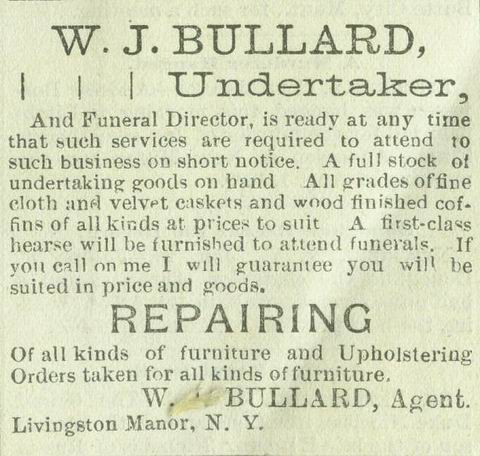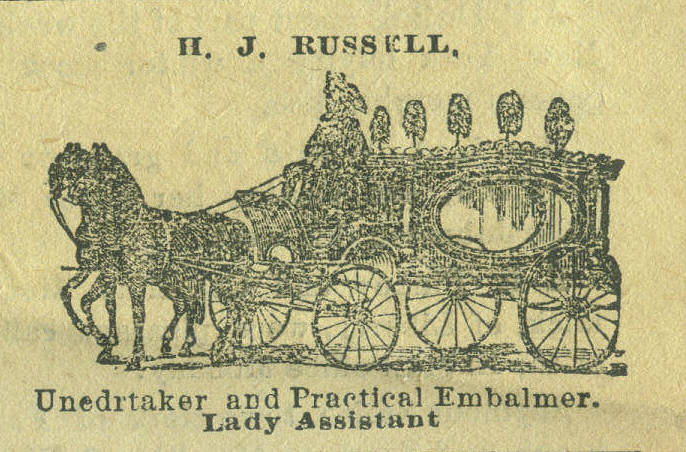Russell Funeral Parlor
March 14, 2010 - Over the course of the past number of years, flooding
along the river and creeks that flow through Livingston Manor has inflicted
serious property damage upon the many residences unfortunate enough to be in
the path of the river valley's designated flood-plane. Still, the
devastation caused over the course of the past few years by these
floodwaters pales in comparison to the destruction amassed in just a few
short hours by the work of large machines designed to destroy. This past
week, three buildings in the Manor area that were included in the federal
flood program, recently signed onto by the Town of Rockland to help mitigate
future flood damage, have been demolished, leaving vacant lots in their
wake. Large excavators tore into the the recently vacated buildings,
clamping its mechanical jaws on building section after section, ripping the
structures apart, leaving a pile of splintered rubble to be carted away. In
just a blink of an eye, well over one hundred years of history has vanished
just like that, traces of which are now relegated only to memories and
photographs.
One of the finer
structures on Pearl Street became one of these victims to the jaws of the
excavator. What was recently known as the Bryant house had been particularly
hard hit by the numerous, recent floods. This large, three story,
four-gabled structure followed an architectural style that was common during
the late nineteenth century. Consideration had been given to preserving the
building and maintaining it as a residence, perhaps by raising the structure
so it would sit above the flood-plane's high-water mark, but its location,
size and other physical aspects to the structure made it cost prohibitive,
joining the growing list of flood-plane structures that are now gone....
 Hawley Russell
and his wife, the former Mary Ellen Davis, moved to the Livingston Manor
area from the Delaware County community of Shavertown in 1889, taking over
the undertaker business of W J Bullard, located across the street from the
Sturdevant House. It was a time when many within the undertaker business who
crafted their own caskets also practiced the trade of cabinet-making, the
finish product being similar in both vocations. It was also a time when
caskets were borne from the funeral to the burial site by horse-drawn
carriages, the area's finest horses leading the somber procession. "Wals"
Davis, proprietor of the Davis House and noted local horseman, provided what
were considered the town's most handsome pair of black mares for these
occasions, housing both mares and funeral wagon at the hotel's stable.
Wishing to expand his business, Russell purchased a building-lot from
Elizabeth Sherwood, Jack's wife, located within the low-lying wetlands below
the Methodist Church in 1895, building his new, large residence, which
housed the undertaker business, along with a stable next door which would
store the hearse and horses.
Hawley Russell
and his wife, the former Mary Ellen Davis, moved to the Livingston Manor
area from the Delaware County community of Shavertown in 1889, taking over
the undertaker business of W J Bullard, located across the street from the
Sturdevant House. It was a time when many within the undertaker business who
crafted their own caskets also practiced the trade of cabinet-making, the
finish product being similar in both vocations. It was also a time when
caskets were borne from the funeral to the burial site by horse-drawn
carriages, the area's finest horses leading the somber procession. "Wals"
Davis, proprietor of the Davis House and noted local horseman, provided what
were considered the town's most handsome pair of black mares for these
occasions, housing both mares and funeral wagon at the hotel's stable.
Wishing to expand his business, Russell purchased a building-lot from
Elizabeth Sherwood, Jack's wife, located within the low-lying wetlands below
the Methodist Church in 1895, building his new, large residence, which
housed the undertaker business, along with a stable next door which would
store the hearse and horses.

Over
the years, the Russell undertaker business flourished at its new location on
Pearl Street, remaining in the Russell family as Hawley's son, James Russell
received his license in 1915. James moved the funeral parlor from the house
into the newly renovated stable in 1925, which was later torn down and the
funeral home completely rebuilt. Later, Russell further renovated the
funeral home in 1939, enlarging the chapel, installing an elevator and
adding a showroom on the second floor. With James' untimely death in 1942,
his wife, the former Loraine Collins, who herself had become a licensed
undertaker, continued on with the business...
For nearly three-quarters of a century, the funeral home at Livingston Manor
was owned and operated by members of the Russell family, until 1962, when
Loraine Russell transferred the business over to Sigmund Berry, while she
retained and continued to reside in the original Russell house next door.
When the Herbert and Kathy Bryant family moved to the Manor, they acquired
both the funeral home and the Russell house. It has been during their tenure
at the Pearl Street residence these past twenty-five years when the
Livingston Manor community experienced what may be considered the worst of
the ever-continuous series of devastating floods, as their home received
arguably the worst of the floodwater damage.
As each flooding event at Livingston Manor appears to become more and more
severe than preceding flooding episodes, the foolishness of allowing
building upon the flood-prone wetlands within the village by early town
developers is now quite apparent. Options for those who now reside in this
flood-stricken area are few; either ride out the wave of floodwaters
generated by the next storm, or join onto the Town's flood program where
both the flood experience along with the homes that they left behind, become
only a memory.